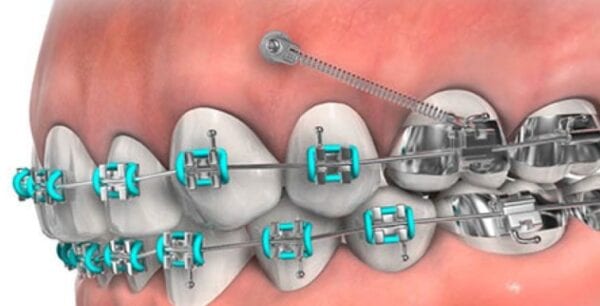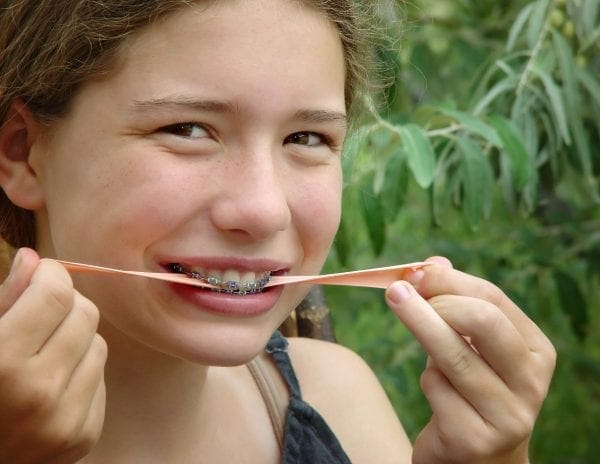What Is a Nance Arch?
Orthodontists use a variety of specialized appliances to treat specific orthodontic issues. Some of these appliances—such as the Nance holding arch—are used to preserve space in the dental arches. The dental arch is the curved structure that contains teeth, gums, and supporting bone. Every human has two dental arches—an upper arch and a lower arch.
The Nance Holding Arch is a space maintainer used in the upper jaw. The device itself is comprised of a few parts, which include:
- Two stainless steel rings (called bands) that are fixed to the upper 6-year molars with orthodontic cement
- A stainless-steel wire that runs around the roof of the mouth (palate) and connects the two bands
- An acrylic plate (called a button) that covers a portion of the wire; gently resting against the roof of the mouth

The button is approximately the size of a quarter and is positioned behind the upper front teeth, so it is not visible when smiling. Looking at a photo of the Nance arch will help patients to understand the construction and parts of the device. This appliance may also be called a Nance Holding Arch Space Maintainer, Nance Palatal Arch, or the Nance Lingual Arch.
Purpose of the Nance Holding Arch Appliance
The Nance Holding Arch serves one major purpose, which is listed below.
- To hold the upper molars in place
The appliance is most often used in younger patients who have experienced an early loss of baby teeth or in cases where a baby tooth requires premature removal for a specific reason. When this happens, the molars may move into the place that should be held “open” for a child’s permanent teeth. If this happens, the permanent teeth may become blocked from erupting, erupt in the wrong places, or erupt at incorrect angles. To prevent this from happening, the Nance Holding Arch is used to hold the upper molars in place by maintaining space in the dental arch for the premolars, canines, or other permanent teeth.
In adult patients, the Nance Arch may be used to keep the molars in place while the front teeth are moved back to close spaces or create a more balanced dental arch.
In other cases, the Nance Arch is used with Temporary Anchorage Devices (TADs) to help the right and left molars move as a unit.

What Are the Benefits of the Nance Holding Arch Space Maintainer?
The benefits of the Nance Arch for patients include the following:
- Preserves space in the mouth so permanent teeth can erupt in the correct areas
- Helps to correct improper bites, including excess front-to-back overbites (overjet)
- Anchors molars as a group, instead of one at a time
- Helps to prevent tongue thrusting, which can lead to bite issues
- Helps to address unfavorable effects caused by thumb sucking and tongue thrusting
- Is painless and virtually maintenance free after a short adjustment period
How Long Do Patients Need the Nance Holding Arch?
The length of time that patients will need to keep the Nance Arch in place will depend on the individual patient and where they are in their orthodontic treatment. Sometimes, this appliance is used after the molars are positioned in their ideal locations with another appliance, such as a pendulum. Time spent wearing a Nance arch can range from just a few months to several years.
What To Expect with the Nance Palatal Arch
As with most orthodontic appliances, there is a brief adjustment period after the Nance Holding Arch is placed in a patient’s mouth. Patients can expect to experience some combination of the following immediately after the device is installed.
- Speech Issues. When a new orthodontic device is installed, it may change speech patterns for a short period of time until the patient adjusts. To assist during this adjustment period, we recommend that patients talk or read to themselves out loud for a few minutes every day. This will help ensure any speech difficulties are resolved quickly.
- Excess Saliva. Whenever something new is placed in the mouth, saliva production may increase for a couple of days. This is perfectly normal, and saliva production returns to normal quickly.
- Soft Tissue Irritation. The button and wire may cause temporary irritation to the tongue or roof of the mouth while it adjusts to the appliance. Patients may use over-the-counter pain medication (such as ibuprofen or acetaminophen; as directed by their doctor) or a warm saltwater rinse until the mouth and tongue adjust to the Nance Arch. In addition, eating soft foods (such as applesauce, yogurt, soup, mashed potatoes, eggs, oatmeal) is recommended for the first few days to reduce any discomfort.
Cleaning and Maintaining the Nance Lingual Arch
Because the Nance Lingual Arch is not removable and is not actively moving any teeth, it does not require much attention. Regardless, to prevent breakage or damage of the wire or button, our top orthodontist, Dr. Ryan Redford, recommends following these guidelines.
- Avoid playing with the wires using your tongue. In addition, patients should not pick or play with the appliance with their fingers.
- Avoid hard, crunchy, sticky, or chewy foods that can get caught in or stuck to the device.
- If the bands feel like they are moving, call our office to get them re-cemented as soon as possible.
- If any part of the device feels loose, broken, or damaged, call our office immediately.

As far as cleaning, patients can brush and floss as normal. However, some additional cleaning suggestions include:
- Rinsing with water at the completion of every meal
- Brushing and flossing three times a day for a minimum of three minutes. Special attention should be paid to the bands, the wire, and the button.
- Using a water flosser, floss threader, or proxy brush to keep the wire and button free of debris.
To learn more about whether you or your child may benefit from a device such as the Nance Holding Arch or to discuss braces for your child, contact Burke & Redford Orthodontists at (951) 699-8011 to schedule a free orthodontic consultation. You may also fill out the form on our website to request a free consultation.